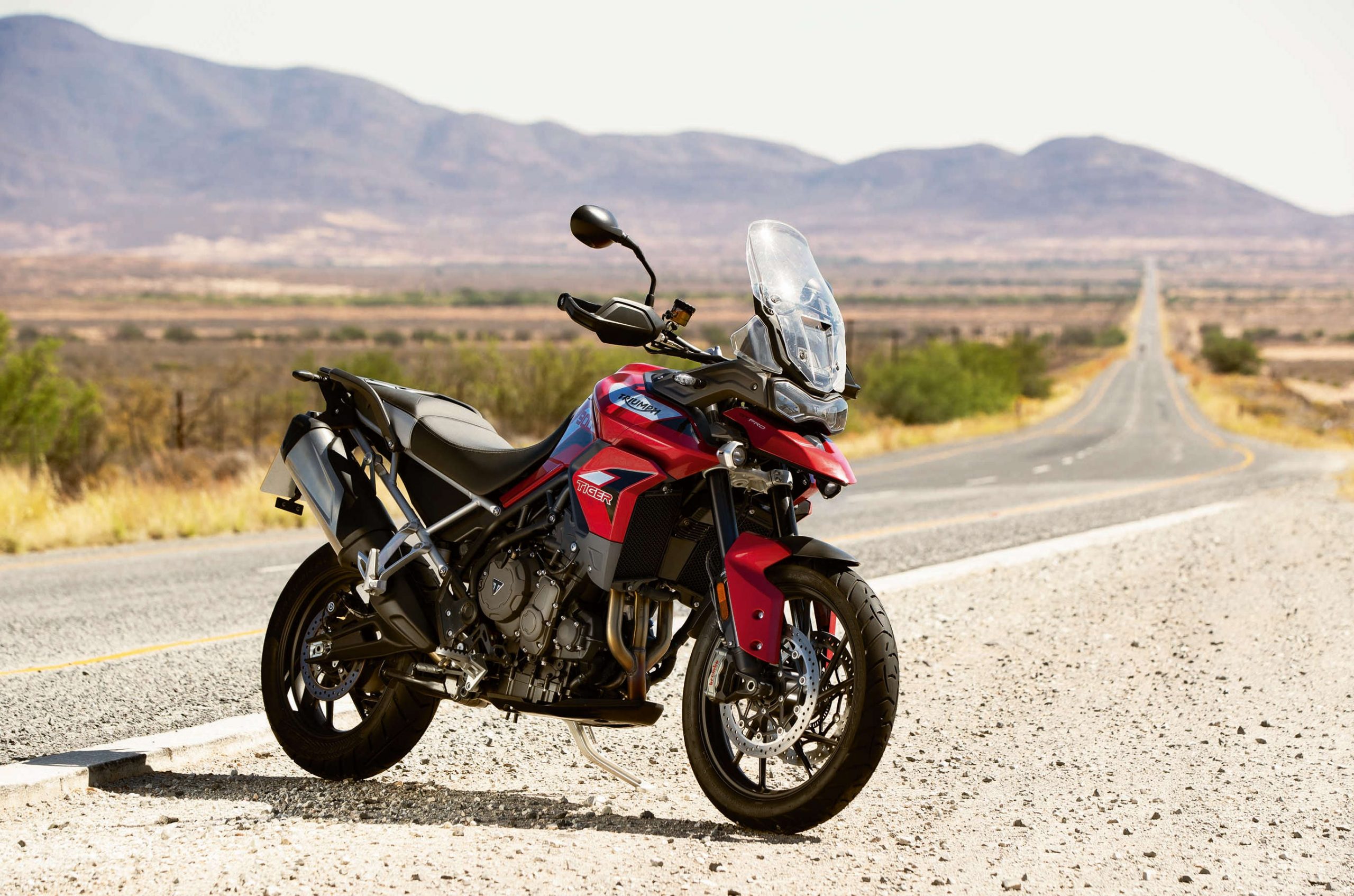
Triumph has replaced its middleweight Tiger models with the all-new Tiger 900 series. Still featuring inline triples, the new bikes get a displacement bump to 888cc with 10% more torque (and the same 94 HP peak). Triumph talks about a new 1-3-2 cylinder firing order improving engine response and rider control.
There are a total of 5 Tiger 900 models, including 3 road-focused bikes detailed below, as well as two “Rally” models with longer travel suspension and spoked 21″ front wheels (the road-oriented models have cast 19″ fronts). Impressively, the bikes are stopped by Brembo Stylema calipers in front. The new models are also a little bit lighter, ranging between claimed dry weights of 423 pounds and 432 pounds.
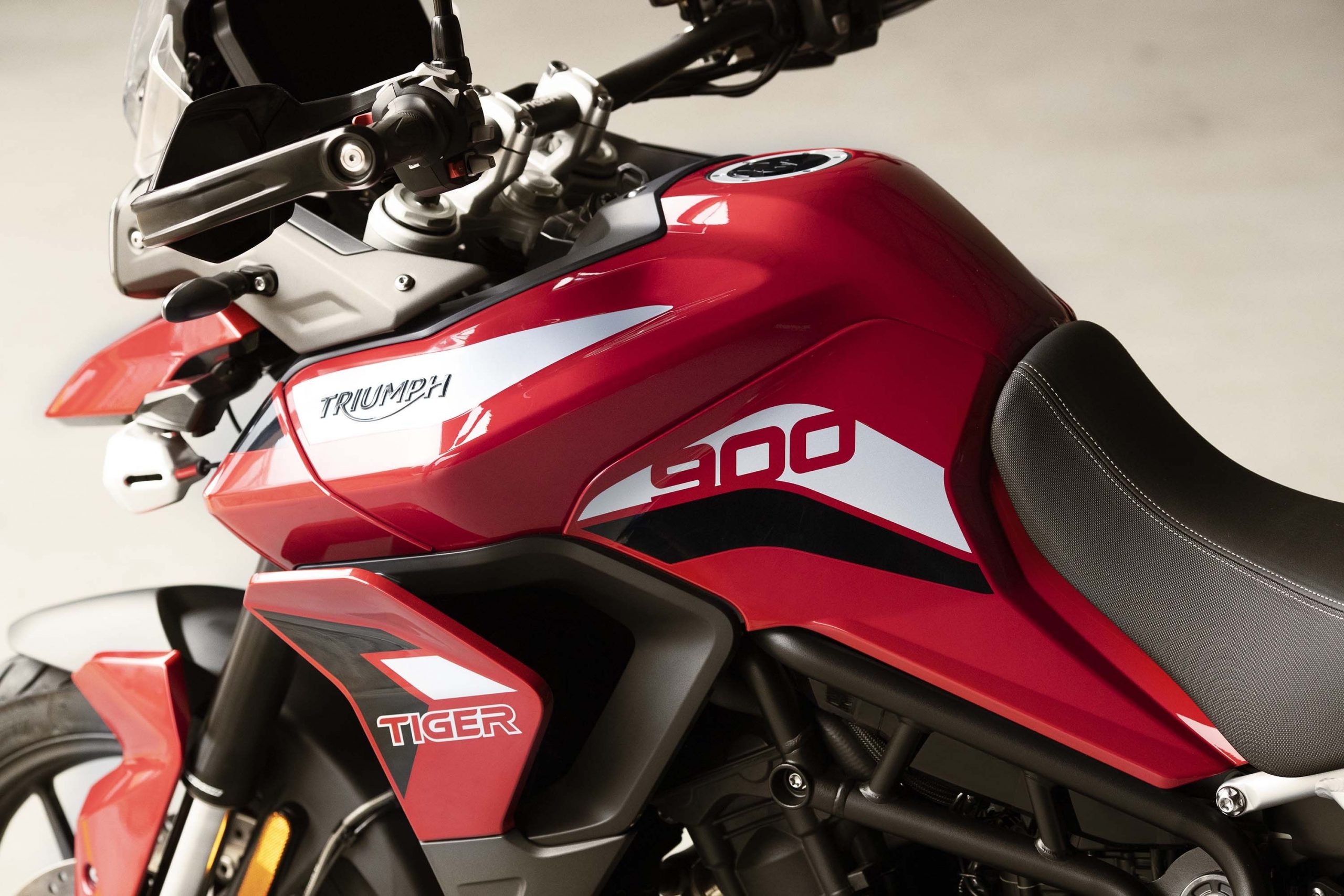
We understand production bikes will reach U.S. dealers beginning in March of next year, and that pricing will range from $12,500 for the base Tiger 900 up to $15,000 for the Tiger 900 Rally. Here are the highlighted features for each of the road-oriented bikes:
TIGER 900
- 900cc triple engine (Euro 5 compliant)
- New lightweight modular frame
- ABS / Traction Control
- LED Headlight
- 5-inch TFT instruments
- 2 riding modes
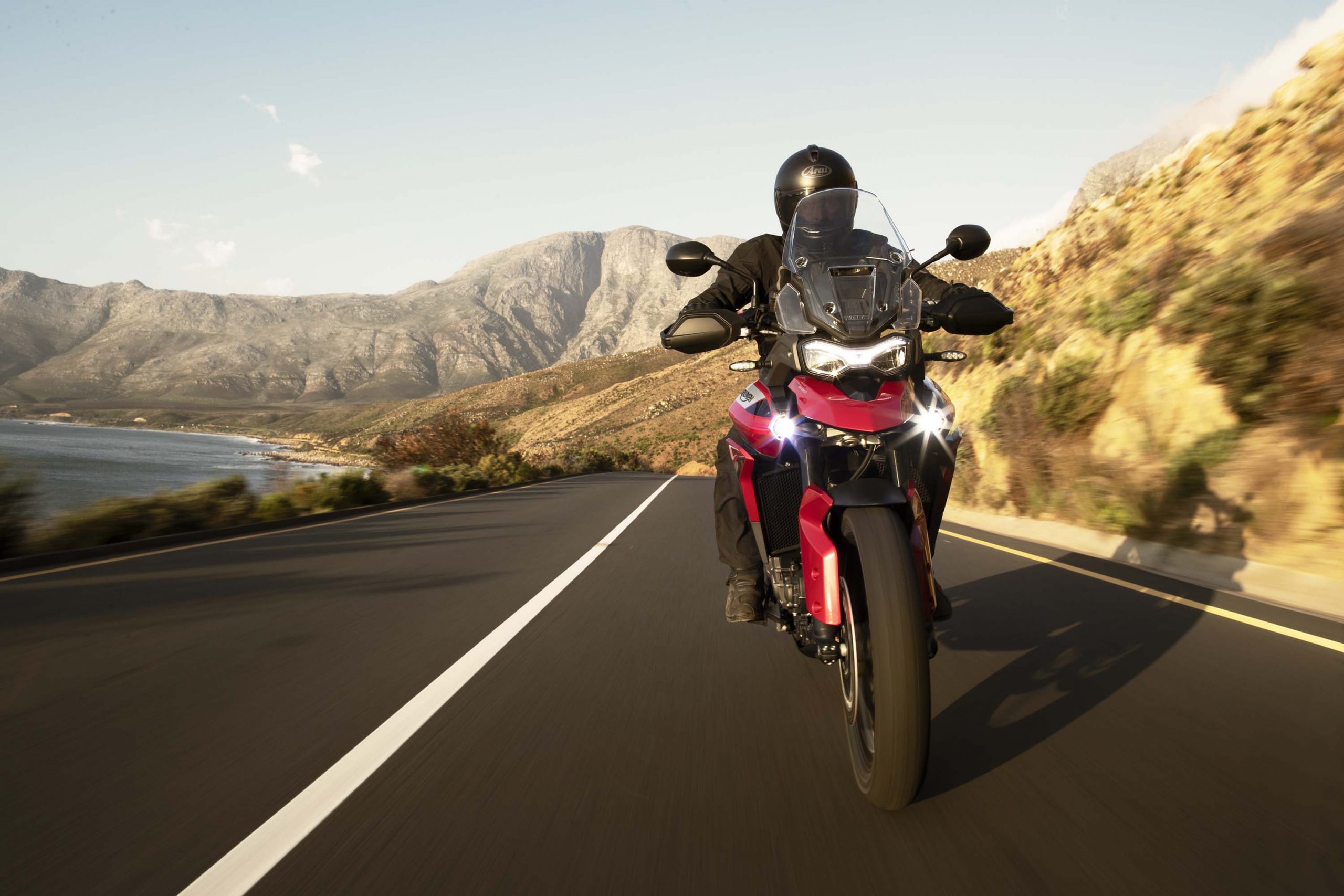
TIGER 900 GT
KEY FEATURES
- 900cc triple engine (Euro 5 compliant)
- New lightweight modular frame
- Optimised cornering ABS and traction control
- LED DRL and Indicators
- Four riding modes
- 7-inch full-colour TFT instruments
- Heated Grips
- Cruise Control
- Hand Guards
- Fully adjustable Marzocchi rear suspension unit
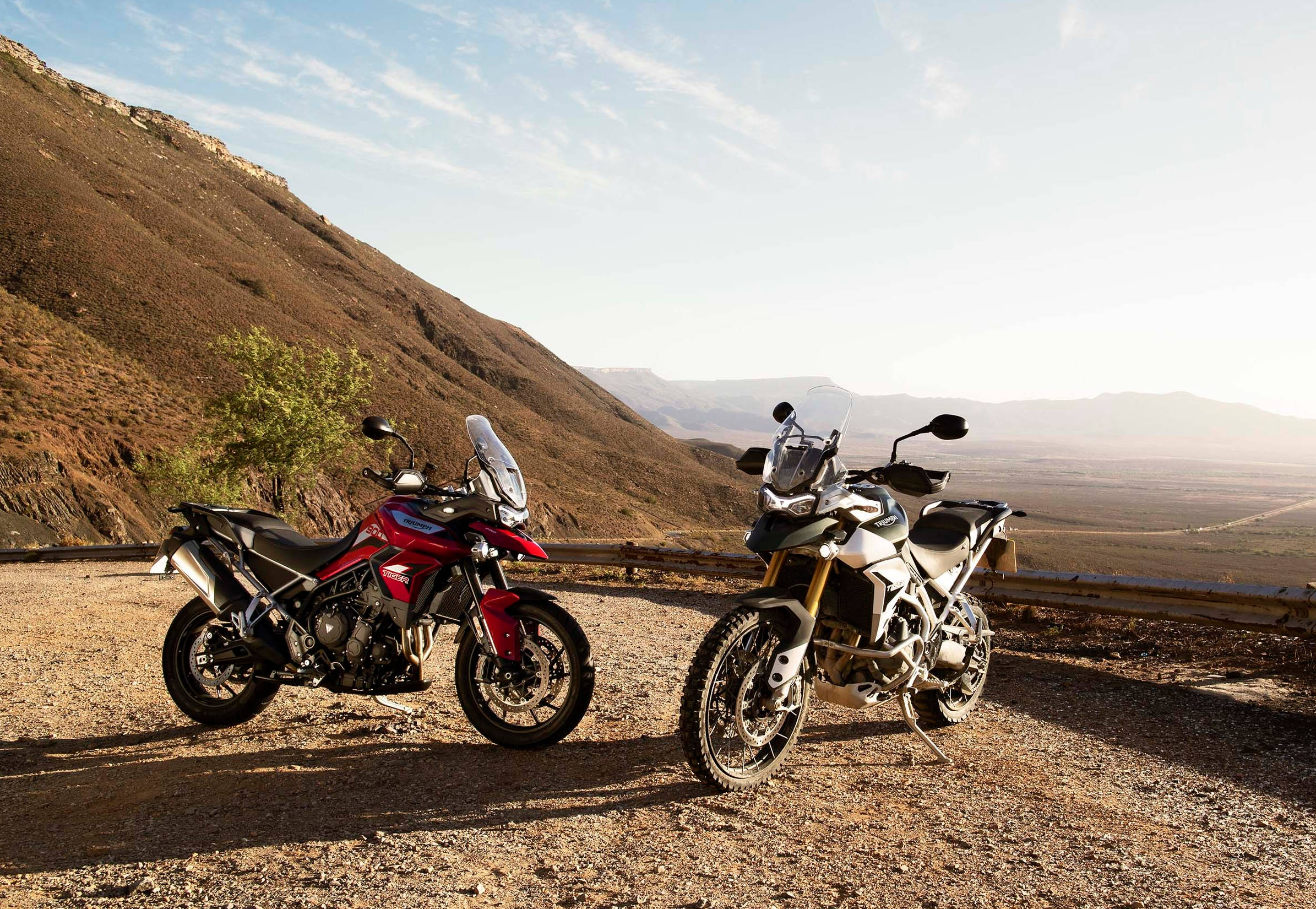
TIGER 900 GT PRO
ALL THE FEATURES OF THE GT MODELS, PLUS:
- 5 riding modes
- My Triumph connectivity system
- Electronically adjustable Marzocchi rear suspension unit
- Triumph Shift Assist
- LED Fog lights
- Centre Stand
- Tyre Pressure Monitoring
- Heated Rider and Pillion Seats
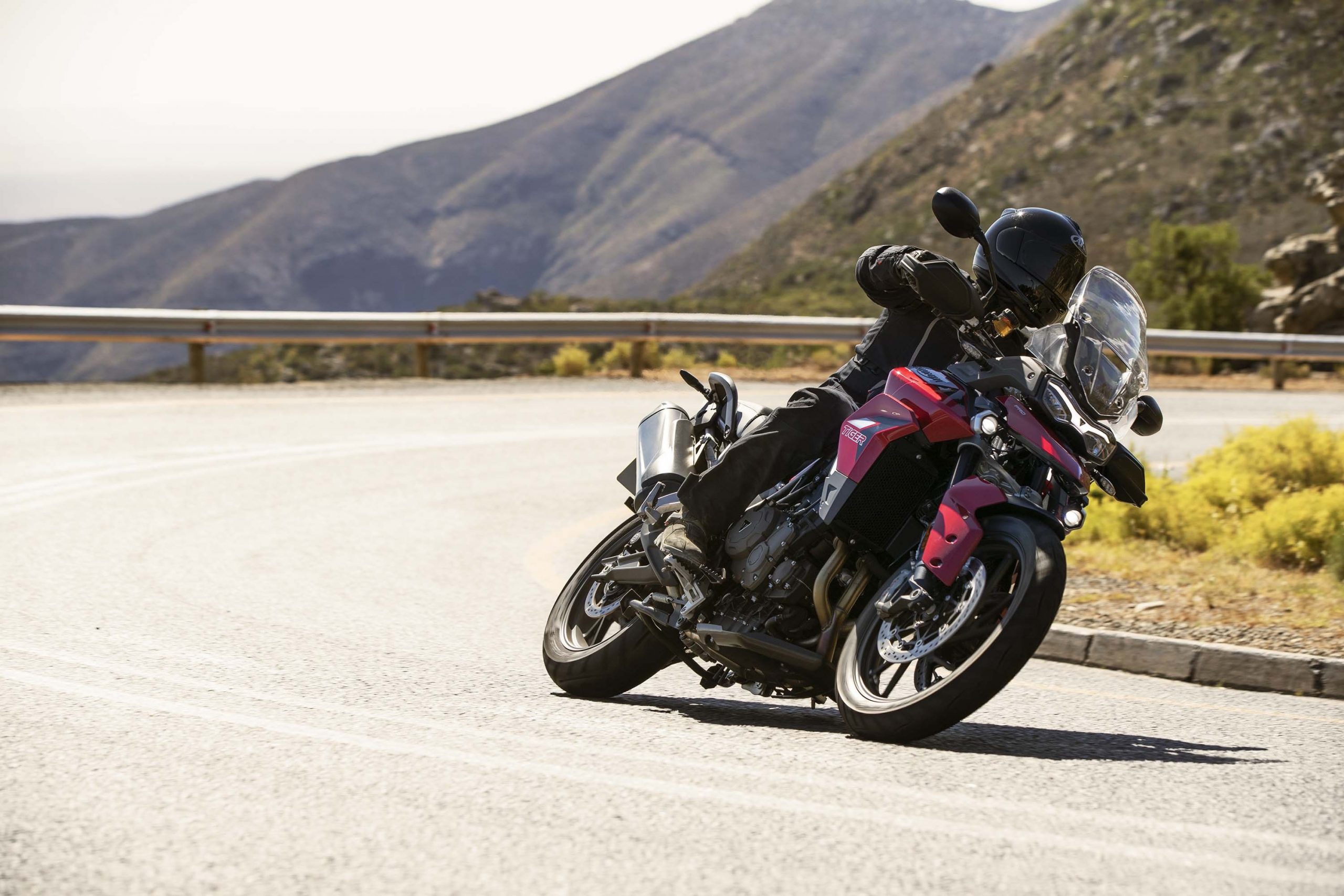
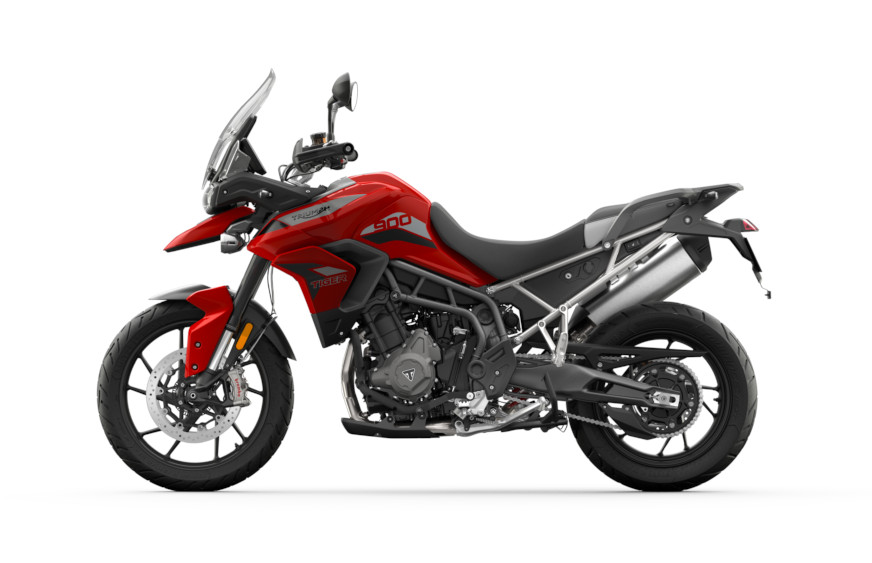
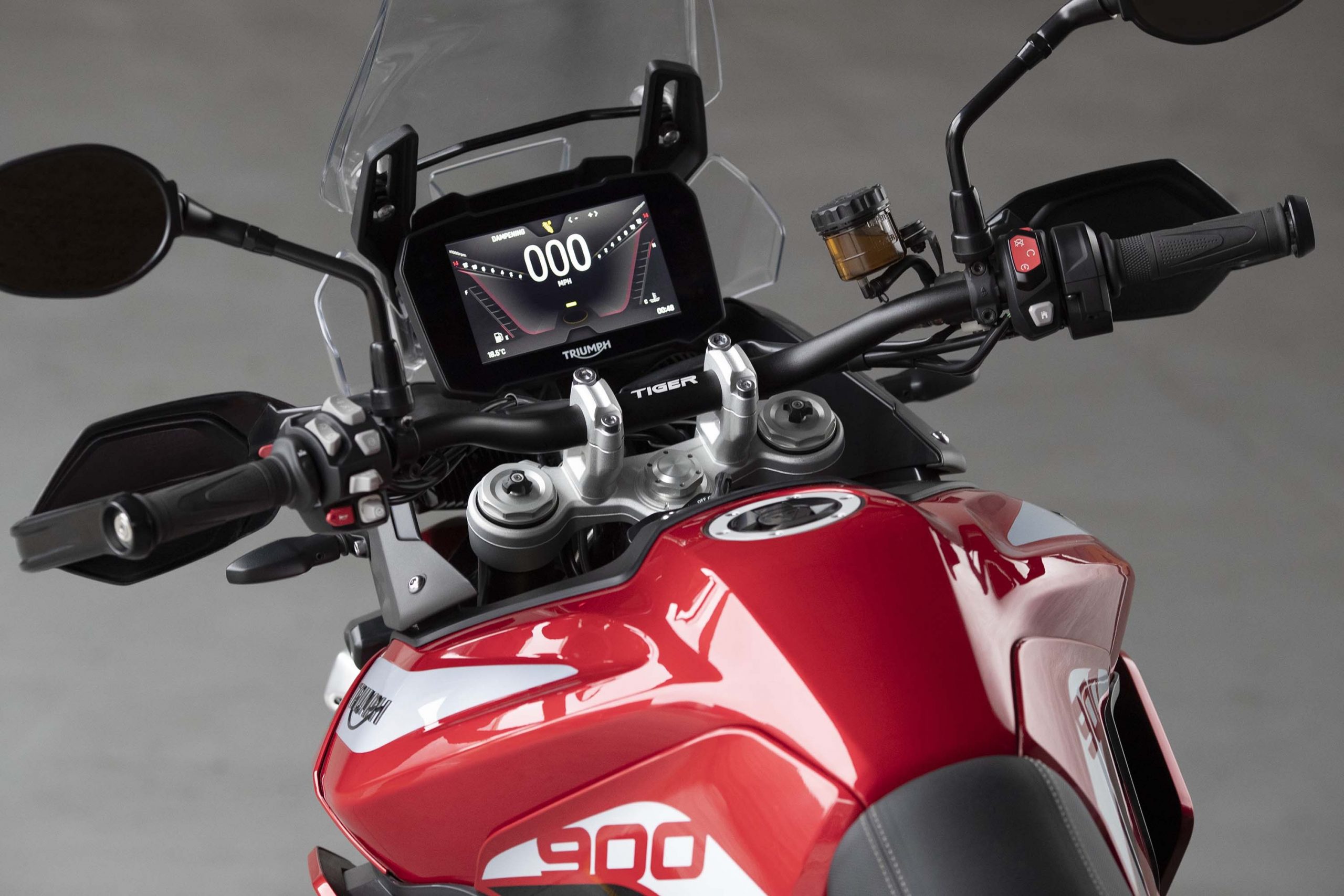
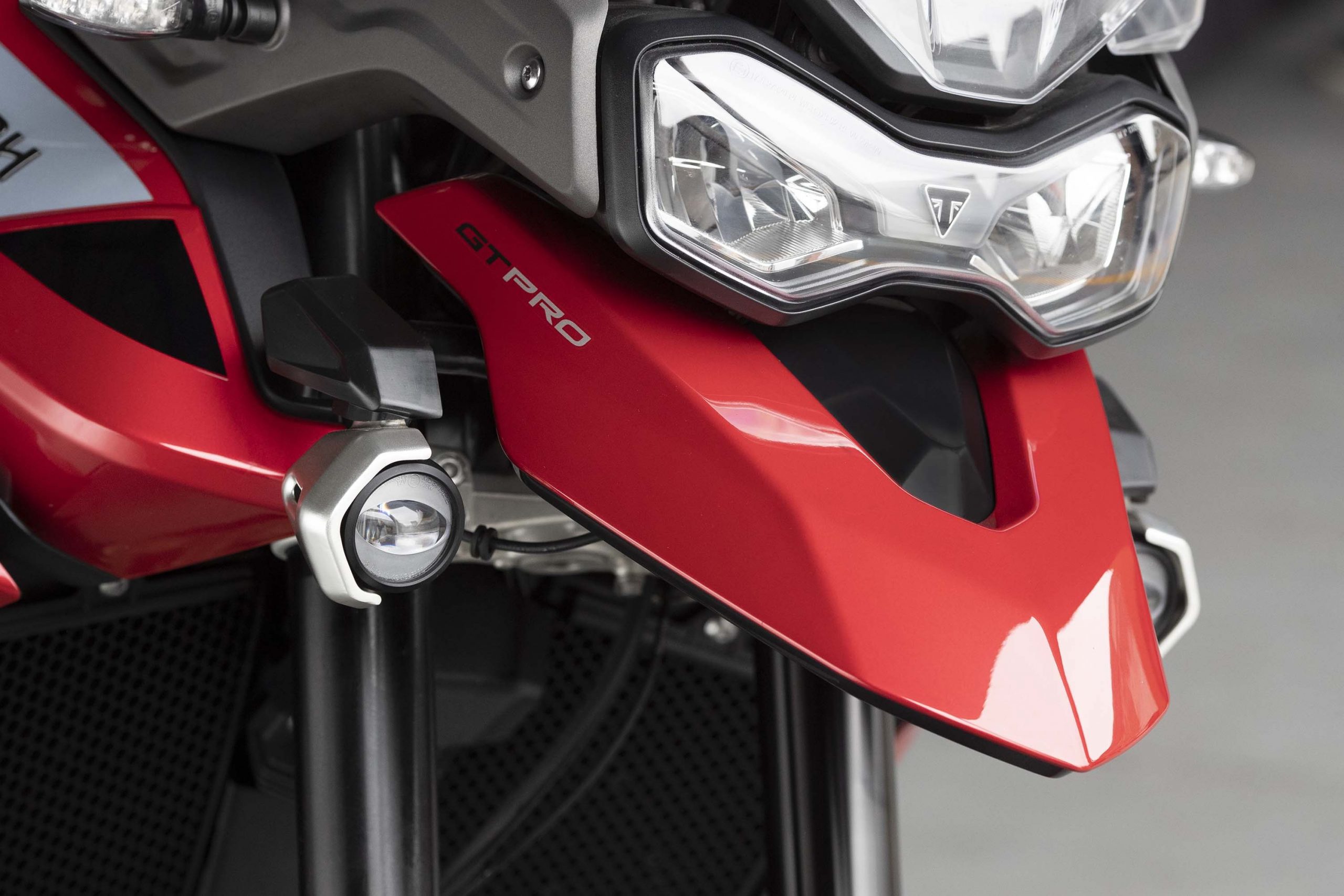
See more of MD’s great photography:






Some bikes don’t look as good in a photograph as in person. I’ve seen the older model and it was a real beauty. I’ll admit I’m a sucker for round headlights but for a modern bike’s this one looks very good. Mechanical bird looking thing it is.
The new crank is interesting. The original engine was smooth and buttery. Was it too nice or something? I wonder what prompted Triumph to go this route? One of the cool things about triples to me is that they sound like triples, not that I’ve ever bought or rejected a bike because of how it sounds.
Prices to a lot of motorcycles have gotten to a point where they just aren’t fun anymore, and this bike falls into that category for me. I’m sure it’s great – it’s predecessor was – but the improvements motorcycles are making just don’t seem to keep pace with their asking prices. Or it is probably fairer to say that most last generation bikes were so good that it is hard to justify spending so much more on the latest machines.
How much cheaper would bikes be without the non-essential electronics? I don’t want and never have wanted rider aides and modes. But they don’t give us that choice. Fuel, ignition and instrumentation systems are essential, but they could eliminate all of the other electronics.
yeah, and get rid of all that extra stuff, like electric starters, hydraulic brakes go back to drums, put some carbs on it will ya, and all that new fangled instrument stuff, shift when it slows. Come’on.
NO, Joe. He’s suggesting they get rid of all the stuff that has little to no performance value. But your comment about carbs; I’ve never ridden a fuel injected bike that ran as smooth as a carbureted bike but that’s more about the necessary over-lean fueling bikes come with now than it is about how the fuel is mixed with the air.
Having experienced all of these newer electronics now, I’d say that the ones that truly add some value to the average rider on bikes that don’t see track duty are lean sensitive ABS and cruise control. The ride modes and traction control just don’t seem to do much of anything. (I wonder how many accidents are the result of losing traction on the rear while accelerating or not having a “rain mode” available for wet streets?) The off-road modes I’ve tried on KTMs and BMWs work noticeably worse than manual operation of the throttle and brakes. I’m sure it will all get better, though, as time marches on.
But ultimately these items have become qualifiers. Buyers expect motorcycles to have these new features, otherwise the bike would generally be seen as providing less value than a competing offering. Stuff has to have tech these days to sell.
The electronic aids are now essential in the market place and they cannot eliminate them if they hope to sell their motorcycles. For every customer who wants the bike without it, there are 10 (20? 50?) who will refuse to buy the bike without them. It’s like manual/automatic transmissions in cars.
What we don’t know is what cost they really add. Considering these pricepoints existed before electronics, I’m betting it’s not as much as we’d like to think.
I think Dave is right. A lot of this stuff is just written thru the ECU and stuff like modes, and cruise. Not sure there is much in the way of pieces that could be eliminated to substantially reduce the cost.
I have 3 bikes in the garage, one has nothing, one has ABS and one has ABS, TC, modes and cruise. Riding them there is no difference, unless I do something stupid (which I haven’t done yet) at which point in reverse order they should help save my bacon in various degrees.
Today its raining. I will ride later on wet roads, and will choose the one with the most rider aids because it’s the safest one.
I think the cat is out of the bag on electronics and now that they are a known entity there is no going back to bikes withoug them.
I have a lot of experience in riding in rain. Years ago I decided that instead of avoiding it I would get good at it. I also have an advantage over many riders because I gained a vast amount of dirt riding experience before I bought my first road bike. When roads are slippery or have loose material on them, dirt riding skills become very useful on tarmac. My greatest strength as a rider is my ability to ‘save it’ in situations where most riders would crash.
Rain Mode on motorcycles lowers the power output and dulls the throttle response. I do the opposite. In wet conditions I use a lower gear for the same speed to keep the revs up for more power and quicker throttle response. Traction Control prevents the rear wheel from spinning. If you loose control in slippery conditions, by spinning up the rear you can ‘rear-wheel steer’ to make the bike go (more or less) where you want it to. If the front wheel slides you can save it by spinning up the rear making both wheels slide. TC can save you in some situations but prevents you from saving yourself in others.
ABS does exactly what it says it will do. It prevents the wheels from skidding so you won’t fall over. Maximum braking is achieved when the wheels are skidding a little. A device that eliminates all skidding does not allow maximum braking to be achieved. Some ABS systems have multiple settings. But in the constantly varying conditions of real-world road riding, no one setting is ideal in all situations. Ignore all of the braking tests and demonstrations you have seen, because nobody brakes at their maximum ability in an artificial situation. Your sub-conscious survival instinct won’t allow you to do it.
From the comments here it seems that average riders prefer to have rider aides. To me they are a waste of money. I’ve ridden like a hooligan for 47 years and have been in far more than my fair share of emergency situations, but have never required medical treatment from a motorcycle accident. Those experiences have made me much safer than average riders. In some situations rider aides will prevent me from using my survival techniques.
Ralph W. – Save a loss of control by “spinning the rear tire in the rain”? “catching a front washout by spinning the rear tire in the rain?” Most of that diatribe you just wrote is pure fantasy.
I’m beginning to wonder if you really ride a motorcycle at all.
Dave, it’s obvious (to me) that I have a high level of riding skill and you don’t. Just because you can’t do it doesn’t mean that nobody can. Do you have a lot of (if any) dirt riding experience in wet slippery conditions where controlling the direction of the bike with the throttle and body movements is just a normal part of riding? It works in the dirt and works the same on tarmac. It’s not something I dreamed up. It is something I do.
“TC can save you in some situations but prevents you from saving yourself in others.” That is the truth. Some of you old guys need to stop pretending you know everything about riding and realize that you only have average skills.
“It works in the dirt and works the same on tarmac. It’s not something I dreamed up. It is something I do.”
No it doesn’t and no you don’t.
Dave, are you one of the people who only ride on good roads in good weather. That’s OK if it is what you want to do. But you won’t be a well-skilled rider if you only do the easy stuff.
I said, “When roads are slippery or have loose material on them, dirt riding skills become very useful on tarmac.” Obviously you have no understanding of what it is like riding in extremely slippery conditions where riding on tarmac becomes like riding on slippery dirt. You probably have little or no dirt riding experience which is where it is easy to learn these skills. Have you ever watched speedway or dirt track racing? Have you ever done a slide on any motorcycle anywhere, ever? You need to accept reality – some riders have far more advanced skills than you do. Your comments prove that you are just a basic low-skilled rider.
“Your comments prove that you are just a basic low-skilled rider.”
Your comments prove that most of what you say, you make up out of thin air, not from real-world experience. I don’t find much of what you say to be credible. People with real skill in a thing don’t brag about it like you do.
This is all pretty interesting to me. I’m not going to make myself out to be Taylor Robert and Marc Marquez in one old fat body, but I have managed a handful of GNCC podiums as an A rider (when I was young) and a few WERA roadracing championships (not as young). Regarding the wet pavement subject, I was always one of the minority who loved racing in the rain. I cherished the test of smoothness v. speed that it presented, and I was good at it, so that made it enjoyable.
I only point those thigs out to substantiate my implied claim in this post that it is possible that I know at least a little bit about the subject at hand. I would hardly go so far as to assume that others are less skilled than I am, nor will I imply anything of the like.
It is definitely true that off-road riding skill is a big benefit when pavement gets sketchy. It is completely ridiculous to assert that wet pavement is just like dirt.
Losing the front on wet pavement followed by saving it by spinning up the rear is complete fantasy. If the bike is vertical enough to not immediately crash upon losing the front on wet pavement, then all that’s required is letting off the brake. If the bike is leaned over enough that this isn’t sufficient, you’re crashing, and no amount of “I’m so very highly skilled” will change that.
To wit, if anyone disagrees with that, take some time searching the web for roadracing wet race saves. You can’t find a more skilled group of riders on pavement (wet or otherwise) than professional racers. There are literally thousands of such saves available on video. Please post up a couple of links that clearly show a rider losing the front, then saving it by spinning up the rear tire.
hint: there are none. Ever.
Now, all of that said, it is demonstrably true that ABS (for example) can be beaten by a skilled rider re: stopping distance on clean, dry pavement. But, clean dry pavement isn’t where you get the benefit. Even with my experience and enthusiasm for rain riding, I know that there is no chance at all that I could achieve a shorter stopping distance on a wet road than I’d get just by a full stomp/squeeze with ABS, and letting the electronics handle it.
Of course people are free to believe what they want to believe. There is a vast difference between ‘rider aids are not 100% effective in improving bike dynamics in every single possible situation’ and ‘overall, modern rider aids make riding safer.’ They do make riding safer, regardless of what the ‘I’ve been riding since WWII and I’ve never needed ’em’ crowd has to say about it.
I should probably stay out of this, but here goes. Weighing in on the DaveA versus Ralph W. debate, I tend to agree with DaveA, but I am not so sure they disagree with each other to a great extent.
Spinning up the rear on a wet road or track in response to losing the front is not going to be a reliable, repeatable technique for saving a crash … even if your name is Marc Marquez (maybe Ralph is more skilled than Marc in this type of situation). Having said that, at relatively shallow lean angles in poor traction (in the dirt or low traction road conditions) I think spinning the rear (or keeping it loose) can make small front end slides easier to deal with. The bike might be more likely to go with the slide and stay upright. The road conditions that make this possible (as opposed to the dirt, where a skilled rider can do this relatively easily and repeatably) are not common. I was at a press launch several years ago, and slid both the front and the rear several times, sometimes simultaneously, on a Ninja 1000 on a beat up road called Santa Rosa Creek Road near Cambria, CA. I was purposely keeping the bike relatively upright because of the presence of gravel and broken asphalt – riding it like a dirt bike in some respects. This wasn’t a casual ride – I was trying to catch and pass several other motorcycle journalists (all of whom were excellent riders) who had a head start. I succeeded, and never felt out of control.
Now, I don’t normally ride like that and wouldn’t recommend it. It is possible, however. What isn’t possible (I agree with DaveA on this) is carrying a significant lean angle (already near your limit) on the street or track in the rain and (a) having the time or(b) the ability to respond to a sliding front end (not a wiggle, a slide) with throttle and rear wheel spin in order to save a crash. Not gonna happen.
So maybe you two don’t disagree. You both sound like excellent riders.
Logical and well put DaveA and I agree with you 100%
“If the bike is vertical enough to not immediately crash upon losing the front on wet pavement, then all that’s required is letting off the brake.”
DaveA, you got one thing right. In really slippery conditions you will have the bike fairly vertical. Big lean angles are not possible. That changes the way the bike behaves and how you ride it. You and Dave are only thinking about a narrow range of scenarios, probably because you have a limited range of experiences. More often than not it is not about braking. It can be when cornering or it is so slippery that you loose control in a straight line. That can happen when there is mud or silt on the road (which often happens in wet weather) or there is enough water to cause partial aquaplaning. In those types of situations it is a very fine line between crashing and staying upright. A situation I’m often faced with is when farm machinery has entered the road and driven along it in wet weather, dropping mud for a considerable distance. You and Dave just haven’t considered (or aren’t aware of) all of the possible situations and without the skills to do it you don’t have the knowledge.
Look at the video of the CRF450L on the next page. Most riders can’t do what he does. Some riders have exceptional skills in some areas. Obviously I can do some things you can’t. End of story. I get sick of arguing with people who don’t know what they are talking about. The important point is – traction control can save you in some situations but prevents you from saving yourself in others. That is what this argument is about.
BTW. Often this is done at a ‘micro level’. You feel a slide starting, correct it before it gets bad, and it isn’t noticeable to observers. It may look like the bike just twitched a little. In an interview with Casey Stoner after he’d won a MotoGP race the interviewer said, “That was a very smooth ride.” Casey said, “I lost the front three times.” He lost the front three times, saved it and won the race, but we couldn’t see it. That is why I don’t waste my time looking for the videos you desire.
I think Marquez will be glad to learn that next time he goes to tip into a turn and loses the front wheel on his RC 213V that all he has to do is spin up the rear wheel to save it. Should make him nearly invincible.
Just so I’m clear…in 9 years of of-road racing and 7 years of road racing, as well as 35 years of road riding, my “range of experiences” isn’t sufficient to have an understanding of riding under various conditions?
You should put down the shovel. Seriously.
/out
My new 690 Duke has ABS, first bike I’ve owned with it. A couple weeks ago, I was hauling the mail ready to beat a red light in a turn. As I was approaching the intersection, I noticed a cop coming to the signal on the other side so I grabbed a bunch of brakes. On my old bikes, I would feel and hear the tires squirming and struggling with traction. It was easy to toe the line between skidding and stopping really hard, modulating braking power with the feedback I receive. On the KTM, the ABS kicked in, braking power was immediately reduced with a sudden drop in braking feedback. I stopped about 10+ feet farther than I felt I would have on my non-ABS bikes. I’m convinced now that I don’t like ABS and would rather not have my braking power reduced to 90% just because I was taking it to 99%. I guess it’s for new riders who will just squeeze the brakes as hard as they can in a panic situation. ABS is a lot of mechanical and technological complexity that indeed adds to the cost of the bike.
As soon as the light turned green, someone ran the red in the other direction. The cop didn’t even bother going after them!
“A couple weeks ago, I was hauling the mail ready to beat a red light in a turn. As I was approaching the intersection, I noticed a cop coming to the signal on the other side so I grabbed a bunch of brakes. On my old bikes, I would feel and hear the tires squirming and struggling with traction. It was easy to toe the line between skidding and stopping really hard, modulating braking power with the feedback I receive.”
Todd…You may have had a different outlook if the road had been wet or had sand or anti freeze on it. You were lucky in that road conditions were optimal for braking that day, yet you only stopped 10 feet longer than normal with ABS. Had the road conditions not been optimal, and instead been a bit slippery you would have probably low sided your new KTM and hurt yourself. It’s a proven indisputable fact that ABS will assist you in braking more safely under less than optimal conditions, regardless of how you feel and Ralph W states.
Then again, you may be one of those riders that only ride when it’s bright and sunny out and 70 degrees on roads you are intimately familiar with, in which case ABS would probably be of lesser importance to you.
In real world conditions ABS is a safety net beneficial to almost every rider.
todd…ABS only kick in due to impending wheel lock up. If yours kicked in, whether you realized it or not, you had already crossed the threshold from maximum braking to skidding.
Mickey, you have very simplistic view of ABS. Many standard systems activate too early. They are designed for less skilled riders. There are systems with multiple settings, and their existence proves that no one setting is ideal in all situations.
If Todd had over-braked (and I’m not saying that he did) it doesn’t mean he would have crashed without ABS. It is easy to correct a skid by reducing the brake pressure, but that is not the natural subconscious reaction for many riders. It has to be learned and the only way to teach the subconscious part of you brain is by doing something repeatedly. But that requires a very lengthy explanation to make it easy to understand.
One of the normal subconscious reactions for many riders in any emergency is to brake hard. If the emergency has been caused by braking too hard and the wheel is skidding they continue to brake hard which doesn’t solve the problem. They don’t realize they are doing it because it is a subconscious reaction, and they actively make themselves crash. That is why they think that when the front wheel skids you will crash and nothing can be done to prevent it. Todd has learnt to do things that you haven’t.
With all due respect Ralph, you have no idea what riding skills I do or do not possess. Like you, I spent 10 years ripping around in Motox competition and picked up a few useful riding skills along the way, and have speng 54 years surviving riding in traffic. But todays motorcycles aren’t made just for those fortunate enough to grow up at a time when dirt bike riding was affordable and available. They are also made for guys who have never had the opportunity to spend time off road, but have had to pick up their riding skills while trying to survive in the concrete jungle. Look I dont care if you want a bike with rider aids or not, the manufacturers dont care about you, they care about the majority, the future, and the majority of riders today want those rider aids plain & simple. So the new bikes are going to come with them whether you like it of not…and that’s the way it is. Cry, fall on the floor, stomp your hands and feet, claim how superior skills you have developed, but that doesnt make one iota of difference to anyone but you.certainly not to the manufacturers who are going to continud to maje safer motorcycles for the majority of motorcyclists.
I’ve found that maximum braking is typically achieved with the tire skidding ever so slightly – not completely stopped, still turning but at a slower rate than the ground. On a non-ABS bike, you can feel where this occurs and you can vary braking pressure to maintain that maximum affect. On an ABS equipped bike you cannot and the system on my KTM removes a significant amount of braking force and feedback. To me, it felt less safe. This was on city streets in Downtown Oakland. Early morning fog,loose asphalt, tar patches, oil spills, pot holes, crack needles…
todd, from what I have been reading online, it is not difficult to disable the ABS on your Duke.
I have some experience in the general field of sensors and cpus. The part cost is amazingly low. As a very, very, rough example, consider a small but powerful computer with an IMU, temperature/humidity/pressure sensors. You can get that *retail* for $70 or so – look up Raspberry Pi.
Sure, the IMU type required may be higher performance, and certainly there are R&D costs to amortize but I’d be surprised if the cost adds up to more than $250.
A $250 cost comes out to around $1,000 to the consumer. ABS adds at least that much too. Digital/LCD/TFT gauges and cast wheels, plastic body parts, etc help reduce cost. Whether that savings makes it’s way to the consumer is another matter.
Looks like you can have a 1-3-2 firing order with a 120 degree crankshaft based on the wikipedia page referenced above. Does Triumph claim to have gone to a flat or 90 degree crank, irrespective of what MCN says. They aren’t known for their accuracy after all.
I got a very lightly used ’18 Tiger 800 xrt and have not had any bike fit me better! Fueling on Triumphs is the best by far, and for me it has plenty of power. Can’t wait to see the 550 triple to fill the smaller bike void would be neat.
This is a good looking bike, but why have they f****d up the engine with a stupid crankshaft? 120 Degrees is excellent. Nice and smooth, and a beautiful, unique sound. And now they want to make it sound like a twin?!?!? WTF were they thinking. As you can tell, they won’t make a sale here.
Without having ridden one, how could anyone say the engine is not as good? It’d be a big risk to change anything so intrinsic to their product so they certainly thought about it very carefully.
Yes, a big risk. And it failed. For me anyway. But there will be plenty of others for Triumph.
Have you already seen/ridden one?
They screwed up the crank phasing on the twin too when they went from a 360 degree to a 270 degree crank. And yes, I’ve owned both. I like the sound and feel of the 360. If I wanted a bike that sounds like a 90 degree V Twin I’d buy a V Twin.
I prefer 90* V-twins (& most recently a V-4), but I’d prefer the firing order, feel, and sound with only one head on the engine to maintain.
So the base Tiger 900 MSRP is $899 less than the V-strom 1050 base’s. Can’t wait for a comparo.
Glad to see a removable rear frame section and removable rear passenger foot pegs. Absence of those items up until now cost them at least 1 sale to a 2014 DL1000A. What’s with the Marzocchi rear suspension? I thought Marzocchi went out of business yrs ago… previously unrebuildable sub-par Suspension. And hopefully individual options such as only a quick shifter will be available and at a reasonable cost.
Bears a striking resemblance to the Africa Twin now. Given how well the AT has sold I don’t blame Triumph for jumping on that styling bandwagon.
Having said that they are two very different motors and the fundamental differences between the two bikes will undoubtedly remain the same. While the AT is a better all rounder the Tiger rules on the highway because of the livelier top end of the triple, the AT will continue to dominate off road with its low end grunt. It will be curious to see if the new firing order will be felt in the seat of the pants off-idle.
It’s great, but where is the Tiger Cub and Tiger Trail small twins? This is more of the same. It never ends.
It’s more of what sells (for them). They have no precedent for small displacement bikes and playing that game puts them in competition with the Japanese/Austrians, both of whom are better at the low-margin products.
For every Honda, Yamaha, Kawasaki, BMW, KTM, Suzuki, etc small bore bike that is sold, that’s one less Triumph sold. It’s a huge market and Triumph is missing out. Some companies think they are too cool or mature for low capacity, light weight, entry level motorcycles. Look how well that turned out for Harley.
“For every Honda, Yamaha, Kawasaki, BMW, KTM, Suzuki, etc small bore bike that is sold, that’s one less Triumph sold.”
The same could be said about Porsche. They make the most profitable cars but they won’t chase the Toyota Corolla & Camry business. Different companies are optimized to operate in different market segments. Triupmh is a much smaller company than those others, who have a huge market share advantage and the pricing that comes with that volume.
Porsche may not make a Camry or Corolla, but they do make a RAV4 and a Highlander. They had to get into the SUV market because that where the money went. They just did it in a very Porsche way that allows them to maintain high margins. Perhaps Triumph could figure out a Triumph way to do the small bike thing. KTM and BMW have both gone there, so they would be in good company. I agree Triumph isn’t optimized to make that leap, but then no one is until they decide that is where they need to go.
“Porsche may not make a Camry or Corolla, but they do make a RAV4 and a Highlander.”
I was referring to price points. I don’t believe any RAV4 or Highlander customer cross-shops Porsche when they’re making their purchase decision.
My wife was looking at the Macan, among others, and ended up going with the Rav4 because it was a hybrid, much to my dismay. She had remarked that she would have bought the Macan if it was available with a manual transmission.
She would’ve spent twice as much ($60k vs. $30k) for a Porsche with a manual transmission, but settled on a hybrid with an auto, instead?
Really?
Every Porsche we ever owned was a manual. We’re not about to buy an automatic one. The Rav4 Hybrid is quite a bit more than $30k and the Porsche was much closer in price than you’d think. She figured, since you are forced to get an automatic in pretty much everything, she might as well get one that gets better mileage.
You can still get a Honda Accord Sport in a manual shift, my son drives one.
Expect to see some smaller displacement bikes born out of their partnership with Bajaj.
I can’t wait to see a comparison of this to the new 2020 Yamaha 900 Tracer GT which I’m contemplating. Price is very similar with the Tracer at $12,999, but it already comes with side cases.
“claimed dry weights of 423 pounds and 432 pounds.”
“Claimed dry weight” = Liar weight. Fill up the tank, start it and let it run for a few minutes (so we are reasonably sure that there is actually oil-and pistons-in the engine), then place the bike on an independently calibrated scale.
Now, I kindly ask all to get off my lawn.
Let us all know when you get a weight that satisfies you. The weights listed are good enough for me for general comparison uses.
Oh.. and I like the styling.
I see one of your feet on my dichondra…
Fill the tank + fill the crankcase, and install the battery. My old SV650, road-ready, weighed 55 pounds above the stated “dry weight.” For a while, companies seemed to be getting away from optimistic “dry weight” nonsense, but their marketing departments evidently won.
They’ve been reading MCD with the constant complaints of weight over 400 pounds.
The firing order thing might just mean that the crankshaft now spins in the opposite direction.
Ya I agree; the marketing hyperbole is pathetic… starting with: “new firing order…”
What happened to the shaft-drive?
That would be a terrible idea on a middle weight. Heavy, saps power (already modest on this bike), hard to change FD ratios to suit the riders need.
Perhaps you are thinking of the Tiger 1200 Explorer? It still has shaft as far as I know.
I loved the shaft drive on the two Yamaha Seca 650s I had in my past. Never had a issue with enough power on those middle weight shaft bikes. I took many trips with luggage and even when I carried a passenger there was enough power. Each to his own.
I also had a ‘82 Seca 650. The engine was super smooth and very powerful. It had no problem outrunning my friends on their SV650 and Ninja 650. It was also a great handler. It really lacked the braking power the others had or the modern credibility. It made up for that in power, value, reliability, low maintenance and a classic 1980’s sport bike looks. Even came with a center stand. I’d say the Seca would be on par with the FZ-6, if it wasn’t for the brakes.
I had an ’81 Seca 650. It really did have impressive acceleration for a 650. I loved the shaft drive because it was clean and required minimal maintenance. I replaced it with a Suzuki GS850 because I got married and wanted a bike that was good for two-up riding. It also had shaft drive. Chain drive is good for racing and serious dirt riding, but on the road shaft drive has some real advantages. More bikes should have it but don’t because it is more expensive. I wish my V-Strom 650 (my ‘everyday bike’) had shaft drive.
shaft drive? shaft drive!? don’t get me started. don’t care about performance or weight. it requires almost no upkeep except to change the shaft oil. had one on my 2001 suzi intruder 1500, and on my 2005 kawi 1600 classic. after those two bikes i did ride a ninja 650, followed by a suzi vstrom 650. so, i bought a wheel stand and learned how to maintain the chain; hehe, took’m to a local private mc garage to replace the chain.
Displacement creep again.
Have ridden the 675 Triple, was a surprisingly nice motorcycle.
I’m surprised at only 94 hp though (although that’s plenty). People usually scoff it it doesn’t break 100. Under 500 pounds fueled up is good.
All 5 models will probably be too tall for me lol.
Finding a Triumph dealer is an issue around here.
The street oriented model has a “short” variant made for men of “average” height like us Mickey, around 30″.
Indeed. The GT with the seat in the low position is 31.88 inches. Sounds perfect for my 5 foot 7 frame. They also have a low model that is 29.5 inches if you would like one even shorter. This looks like an amazing bike!
I really like this bike, and have demo ridden it several times, but just can’t get past the price tag.
My 2005 Tiger 950 was a fabulous bike, though it was always dissed because of looks. Then they got bigger. Now, they’re back to 900.
Looks like a great ride.
Please, Please, Please Import the Tiger Sport.
1-3-2 firing order. Improving engine response and rider control? Hmm, sounds most like marketing folly. Will be interesting to see if this is the case.
Wikipedia’s “Straight-three engine” article has a nice animation. It’s a long bang setup with equal time between power strokes as opposed to three power strokes followed by three exhaust strokes in a 1-2-3 setup. I imagine it could feel smoother at lower revs. I wonder how many riders have the sensitivity to tell a difference.
After watching that animation, I’m having a hard time envisioning an alternative with a 120* crank, though I guess it’s similar to the “Big Bang” format employed in the 2T 500cc GP days.
From MCN: “the new crank is at 0, 90, and 180-degrees, and the firing intervals are now at 180-degrees, 270-degrees and 270-degrees for a completely different feel, with a wider spacing between firing pulses, for improved tractability off road – and it sounds so different, more like a twin and nothing like a triple.”